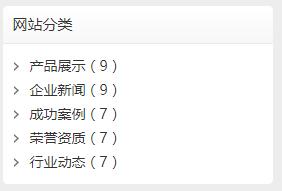获取所有分类列表
通过函数 get_categories() 就可以输出 wordpress 获取所有分类列表 大致写法: 1 …
通过函数 get_categories() 就可以输出 wordpress 获取所有分类列表
大致写法:
|
1
|
<?php $categories = get_categories( $args ); ?>
|
$args参数及默认值:
|
1
2
3
4
5
6
7
8
9
10
11
12
13
14
15
16
|
<?php
$args = array(
‘type’ => ‘post’,
‘child_of’ => 0,
‘parent’ => ”,
‘orderby’ => ‘name’,
‘order’ => ‘ASC’,
‘hide_empty’ => 1,
‘hierarchical’ => 1,
‘exclude’ => ”,
‘include’ => ”,
‘number’ => ”,
‘taxonomy’ => ‘category’,
‘pad_counts’ => false
);
?>
|
参数说明:
type
(字符)post和link 其中link在新版3.0以后已被弃用。
child_of
(整数)仅显示标注了编号的分类的子类。该参数无默认值。使用该参数时应将hide_empty参数设为false
parent
(整数)只显示某个父级分类以及下面的子分类(注:子分类只显示一个层级)。
orderby
(字符)将分类按字母顺序或独有分类编号进行排序。默认为按分类 编号排序包括ID(默认)和Name
order
(字符)为类别排序(升序或降序)。默认升序。可能的值包括asc(默认)和desc
hide_empty
(布尔值)触发显示没有文章的分类。默认值为true(隐藏空类别)。有效的值包括:1(true)和0(false)
hierarchical
(布尔值)
将子类作为内部列表项目(父列表项下)的层级关系。默认为true(显示父列表项下的子类)。有效值包括1 (true)和0(false)
exclude
(字符)除去分类列表中一个或多个分类,多个可以用逗号分开,用分类ID号表示
include
(字符)只包含指定分类ID编号的分类。多个可以用逗号分开,用分类ID号表示
number
(字符)将要返回的类别数量
pad_counts
(布尔值)通过子类中的项来计算链接或文章。有效值包括1(true)和0(false),0为默认
taxonomy
(字符)返回一个分类法,这个是wordpress3.0版本后新添加的一个参数。返回的值包括category(默认)和taxonomy(一些新定义的分类名称)
示例:显示分类列表和分类描述以及包含的文章数目
|
1
2
3
4
5
6
7
8
9
10
11
12
|
<?php
$args=array(
‘orderby’ => ‘name’,
‘order’ => ‘ASC’
);
$categories=get_categories($args);
foreach($categories as $category) {
echo ‘<p>Category: <a href=”‘ . get_category_link( $category->term_id ) . ‘” title=”‘ . sprintf( __( “View all posts in %s” ), $category->name ) . ‘” ‘ . ‘>’ . $category->name.‘</a> </p> ‘;
echo ‘<p> Description:’. $category->description . ‘</p>’;
echo ‘<p> Post Count: ‘. $category->count . ‘</p>’;
}
?>
|
http://www.2zzt.com/jcandcj/8858.html
本文收集自互联网,转载请注明来源。
如有侵权,请联系 wper_net@163.com 删除。

评论功能已经关闭!